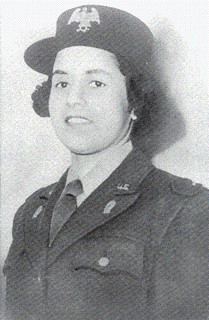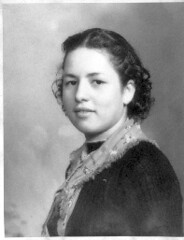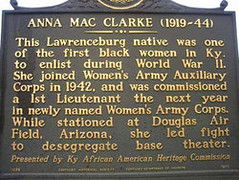Story by John Trowbridge, Kentucky National Guard
Wrapping up Black History Month and leading into Women's History Month, kentuckyguard.com presents this unique look at a woman who swore to fight for her nation and ended up combating social justice ....
[caption id="" align="alignleft" width="209"]

1st Lt. Anna Mac Clarke was a pioneer, part of a unique group of women who came together to help their country win a world war. She and her sister Soldiers also fought another war at home; that of racism, and they, as one unified force, began to break down the barriers of her race and gender which would eventually lead to the civil rights movement of the late 1940s, up through the 1960s.
FRANKFORT, Ky. -- “It was raining that April morning as the train rolled into the station at Lawrenceburg, Kentucky. It was one of those day-long rains that slows the world down and gives you time to reflect. They had been waiting to meet the train that was bringing her back home. Home to her final resting place, this young woman who had, in the short span of 24 years, accomplished so much, not only for herself but for her race and her gender.” From the introduction to A Study in Military Leadership, 1997
Anna Mac Clarke was born June 20, 1919 in Lawrenceburg, Kentucky. Anna Mac, as she was called, was always known by her neighborhood friends as a “tomboy” who liked to play football and take care of animals, specifically cats and her pet chameleon. While growing up in her small town community, Clarke’s peers and elders knew that she was destined to do something great.
On May 28, 1937, less than one month before her 18th birthday, Clarke was awarded a diploma from Lawrenceburg High School, which at the time was referred to as the “Colored High School.” After graduating from high school, Anna Mac decided to pursue a college education. She considered many options, but in the end decided to attend Kentucky State College (now KSU), an historically black college located in Frankfort, Kentucky which is less than 15 miles from where she grew up in Lawrenceburg. While at Kentucky State, Clarke was a very active student, participating in sports, Delta Sigma Theta Sorority, and the school's newspaper,
The Kentucky Thorobred. Clarke graduated from Kentucky State College in 1941, earning a Bachelor’s degree in both sociology and economics. However, Anna Mac had a hard time finding employment that was appropriate for her skills and was not extremely low paying.
In 1942, Anna Mac Clarke joined the All-Volunteer Women's Army Auxiliary Corps and left for Basic Training at Fort Des Moines, Iowa. After she completed Basic Training, Clarke went on to Officer Candidate School.
[caption id="" align="alignright" width="184"]

Anna Mac Clarke's high school photograph.
On November 30, 1942, the Officer Candidate School at Fort Des Moines in Iowa –where Clarke was stationed—was desegregated. Within two weeks of the desegregation, Clarke became a candidate in the 15th Officer Class, WAAC OCS Program. There were two other African Americans in her class, but she would be the only one to finish the course eight weeks later on February 16, 1943. By the end of February, Clarke was reassigned to the Fourth Company, Third Regiment, as a Platoon Leader. Third Officer Anna Mac Clarke was the first African-American WAAC assigned to command what was otherwise an all-White unit.
With First Officer Sara E. Murphy, Clarke led a unit of 144 African-American WAACs to serve in Wakeman General Hospital at Camp Atterbury in Indiana. This assignment lasted for only a month, and in June 1943, Clarke worked in the Classification and Assignment Department of WAAC headquarters in Washington, D.C. She enrolled in the Adjutant General’s School at Camp Meade, Maryland, and after having completed the training she was assigned to Chicago’s WAAC recruiting program. Clarke was promoted to second officer on July 16, 1943, and she returned to Fort Des Moines. The Army transformed the auxiliary units of WAAC into the Regular Army, and Clarke became a member of the Women’s Army Corps (WAC) in September 1943.
Protesting enforced segregation
On February 7, 1944, Clarke led the first WAC unit onto the base at Douglas Army Air Field. Located in eastern Arizona, this Army Air Field was one of only four in the U.S. to have both African-American soldiers and WACs. The theater on the post was segregated, and Clarke had been warned by the African-American soldiers not to go there. However, Clarke and several women went to the theater, refusing to sit in the colored section. She protested the enforced segregation to the theater management, her immediate supervisor and then the Commanding Officer, Colonel Harvey E. Dyer. On February 21, 1944, Colonel Dyer issued the order to his officers “to educate properly all enlisted and civilian personnel in your respective departments to accept any colored WACs assigned as you would any white enlisted man or enlisted woman in the Army of the United States. Every consideration, respect, courtesy and toleration will be afforded every colored WAC. No discrimination will be condoned.”
In March 1944 Anna Mac was admitted to a hospital on the base with sharp pains in her side. Doctors diagnosed her with appendicitis, and decided that she needed an appendectomy to save her life. At first it was believed to be a successful surgery and Clarke was expected to make a full recovery. Unfortunately, gangrene had entered her body due to the infection brought on by the surgery.
1st Lt. Anna Mac Clarke died on April 19, 1944, at the age of 24.

She was buried back home in Lawrenceburg, where a Kentucky historical marker located on the grounds of the courthouse now tells her story.
One person can make a difference
Anna Mac Clarke was a pioneer, part of a unique group of women who came together for one purpose, to help their country win a world war. She and her sister WAACs would also fight another war at home; that of racism, and they, as one unified force, began to break down the barriers of her race and gender which would eventually lead to the civil rights movement of the late 1940s, up through the 1960s. Anna Mac would never know the full impact her efforts to right injustice would have on things that we take for granted today, not only in the military, but in the civilian world as well.
On July 26, 1946, a little over two years after her death, President Truman issued Executive Order 9981, which called for equal treatment and opportunity for blacks in the military. Four years later on March 1, 1950, the President's Committee on Equality of Treatment and Opportunity reported that beginning in April 1950 the Army's quota system for blacks was out and that segregation was over in the military.
As for the WAC, in 1947 members of the WAC were permitted to opt for service in either the army or the newly separated air force. The Women's Armed Services Integration Act gave women permanent military status in the regular army or reserves. Finally, in 1978, the WAC itself was disestablished and its members were assigned or could enroll in all branches of the army and air force.